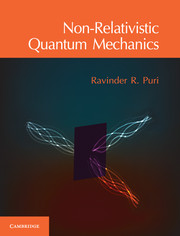Book contents
- Frontmatter
- Dedication
- Contents
- Preface
- 1 History of Quantum Mechanics
- 2 Vectors and Operators
- 3 Finite Dimensional Spaces
- 4 Function Space
- 5 Postulates of Quantum Mechanics
- 6 Density Operator
- 7 Measurement Postulate and Paradoxes of Quantum Mechanics
- 8 Position and Momentum Representations
- 9 Schrödinger Equation in One Dimension
- 10 One-Dimensional Piecewise Constant Potentials
- 11 One-Dimensional Exactly Solvable Continuous Potentials
- 12 Partially and Completely Periodic Potentials
- 13 Harmonic Oscillator
- 14 Three-Dimensional Central Potentials
- 15 Symmetry in Quantum Mechanics
- 16 Quantum Theory of Angular Momentum
- 17 Approximation Methods
- 18 Entanglement and Local Hidden Variable Theory
- Appendices
- References
- Bibliography
- Index
17 - Approximation Methods
Published online by Cambridge University Press: 16 July 2025
- Frontmatter
- Dedication
- Contents
- Preface
- 1 History of Quantum Mechanics
- 2 Vectors and Operators
- 3 Finite Dimensional Spaces
- 4 Function Space
- 5 Postulates of Quantum Mechanics
- 6 Density Operator
- 7 Measurement Postulate and Paradoxes of Quantum Mechanics
- 8 Position and Momentum Representations
- 9 Schrödinger Equation in One Dimension
- 10 One-Dimensional Piecewise Constant Potentials
- 11 One-Dimensional Exactly Solvable Continuous Potentials
- 12 Partially and Completely Periodic Potentials
- 13 Harmonic Oscillator
- 14 Three-Dimensional Central Potentials
- 15 Symmetry in Quantum Mechanics
- 16 Quantum Theory of Angular Momentum
- 17 Approximation Methods
- 18 Entanglement and Local Hidden Variable Theory
- Appendices
- References
- Bibliography
- Index
Summary
Not many problems in quantum mechanics are analytically exactly solvable. The methods of solving the equations approximately therefore play an important role. Though construction of approximate solution would depend on a particular problem, there are methods, discussed in this chapter, which are of general interest as they are applicable to widely occurring situations. These methods can be divided into two categories: one for time-independent and the other for time-dependent Hamiltonians. These categories can be divided further into two classes: one in which the Hamiltonian can be divided in to a strong and a weak part allowing the weak part to be treated as a perturbation, and the other in which certain gross features of the interaction suggest approximation methods for its treatment. The quasi-classical approximation for stationary states, and the adiabatic and sudden approximations for time-dependent Hamiltonians are the examples of non-perturbative techniques.
WKB Approximation
The quantum theory is expected to approach the classical theory in the limit of de Broglie wavelength becoming small compared with the distances over which the potential varies. In that limit, the Schrödinger equation reduces to the Hamilton–Jacobi equation of classical mechanics. The method outlined in this section consists in finding that solution of the Schrödinger equation which contains lowest order quantum effects when the conditions for the classical approximation hold. We will see that this approximation closely reproduces the quantization rule of the old quantum theory. Consider the time-independent Schrödinger equation of a particle of mass m in the time-independent potential V(r),
Information
- Type
- Chapter
- Information
- Non-Relativistic Quantum Mechanics , pp. 337 - 376Publisher: Cambridge University PressPrint publication year: 2017
